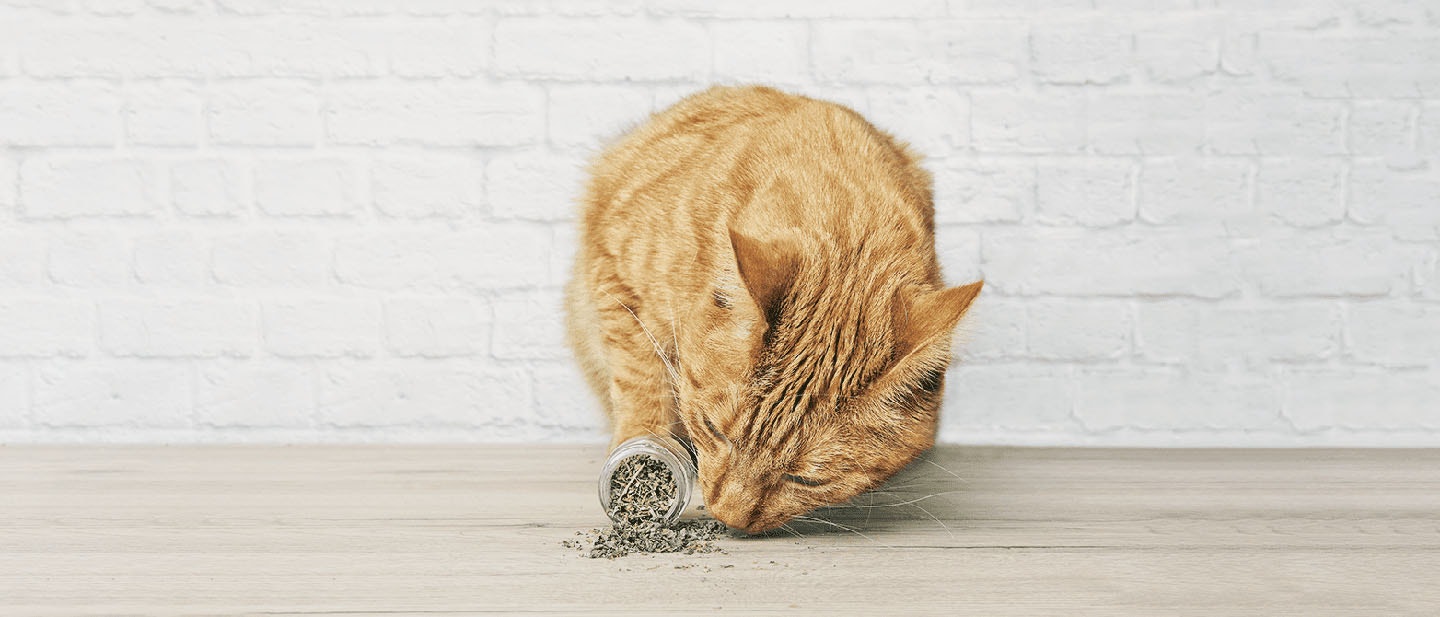
What is Catnip And What Does it do to Cats
As a cat parent, you must already know that having plants indoors can prove to be a challenge if you are fostering a fabulous feline. And while houseplants never really stand a chance against the mighty paws and teeth of our furry munchkins, there is an exception to this. Nepeta cataria, is a well-beloved plant among the feline community, earning it the name ‘Catnip’.
The catnip plant is known for the distinctive effects it has on cats, which can range from rolling or rubbing in the catnip plant, as well as pleasantly zoning out. So, what is catnip and what does it do to cats? Catnip is a delightful treat for cats and can also be efficiently used to train or bond with your precious furry munchkin. Given the wonderful effects of catnip on cats, this article discusses more about the catnip plant as well as how to can be offered to our fabulous furballs.
What is Catnip?
Wondering what is catnip, what is catnip used for, and what does catnip do to cats? If you want to know what is catnip, it is nothing but a vigorous, weedy plant that is abundantly found in temperate climates. Catnip, or catmint is known for the euphoric reaction it has on felines.
So, what does catnip do to cats, and what is catnip made of? Catnip has aromatic leaves that contain nepetalactone, a known cat-attractant. What does catnip look like? Catnip belongs to the mint family, and has a vigorous foliage and branched stems. Catnip also has grey-green triangular to ovate leaves that grow up to 3 inches in length and have a pungent smell.
Origin of Catnip
Catnip is primarily native to Eurasia, and is most abundantly found in the temperate areas of the world. Although there is no documented record of the origins of catnip, the use of catnip or catmint can be traced back to the ancient Egyptians, who offered it to their beloved felines. It was only in 1941 that Samuel McElvian discovered the presence of the essential oil nepetalactone in catnip, which causes the unusual behaviours in cats.
If you are worried about what is catnip or what is catnip used for, catnip was popularly used in herbal medicines and cooking.
Different Catnip Ingredients
Wondering what is catnip and what does it do to cats? While offering fresh catnip to your royal kittiness might not always be a cakewalk, if you are able to grow catnip indoors, your cat will appreciate you all the more for it! Challenging as it may sound, growing catnip at home is relatively easy, as long as you can provide suitable growing conditions. This herbaceous perennial plant grows abundantly in a sunny environment, and can keep your furry munchkin happy and content with a steady supply of catnip all around the year.
And as much as catnip might excite your precious munchkin, have you wondered what does catnip do to cats, or what is catnip made of? The ecstatic high of cats under the influence of catnip is the result of the essential oil nepetalactone, which influences the olfactory bulb to trigger the pleasure centres of the cat’s brain. However, the euphoric reaction of catnip can be felt by only 75% of the cats, beginning at about 8 weeks of age. The state of euphoric high in cats can last for 10 to 15 minutes, and can only be induced at least an hour after the effects have completely worn off.
How to Use Catnip
So, what is catnip and what does catnip do to cats? Mentioned below are some of the most efficient ways to use catnip:
Fresh catnip
If you are looking to grow catnip for your housecat, choosing the right spot is important. When it comes to what is catnip, the catnip plant thrives in sunlight, so wide-open spaces such as a garden with well-drained soil are the perfect spot for growing catnip. Furthermore, the catnip plant is drought-tolerant and grows best with limited water supply. Watering your catnip in smaller amounts to make sure the soil around is moist is sufficient for yielding fresh catnip for your adorable furball.
Dried catnip
If growing your own catnip is not a feasible option, you can look for commercially available dried catnip as the next best alternative for your kitty. Dried catnip is widely available at pet stores, and can be easily sprinkled on your cat's play area, food, and even bedding, and watch them at their happiest.
Catnip sprays or bubbles
If fresh or dried catnip is not your top choice, why not look for catnip sprays or bubbles? Commercially available catnip is often synthesized into catnip that can be sprayed or added to the humidifier at home, allowing your furry munchkin to enjoy their favourite catnip all day! Catnip sprays are incredibly convenient, and can also be used to help your kitty in alleviating stress while shifting to a new locality or during visits to the veterinarian.
Toys stuffed with catnip
As playful as feline furries are, it is not surprising that stuffing their favourite cat toy with catnip is going to be an instant hit with your feline buddy. In addition to chew catnip toys or catnip balls being available commercially, you can also spray your cat’s favourite toy with catnip and watch them go crazy with happiness.
Can Cats Eat Catnip? Is It Safe? Is there any Side Effect of Catnip?
If you are offering catnip to your precious furbaby for the first time, be prepared for a heartwarming reaction in your kitty, which could include purring, actively smelling, and even rolling in the catnip in delight. This is because the nepetalactone in catnip is known to take over the pleasure points of the feline brain, resulting in a reaction comparable to a sexual response.
In addition to the mood-enhancing effect catnip has on cats, some of our feline friends do not just stop at smelling or rolling in catnip, but also eating it as well, making their cat parents worry that, is catnip safe for feline consumption. So, what is catnip and what does it do to cats, or whether catnip is good for cats? Yes! Eating catnip is completely safe and does not cause any adverse effects in cats. In fact, eating catnip results in the nepetalactone present in catnip can influence your cat’s olfactory senses, sending them into a fit of delight and ecstasy. Furthermore, catnip is non-addictive, and suitable for feline consumption.
While smelling the best catnip for cats often causes cats to feel hyperactive, chewing on the catnip plant or eating dried catnip can have a sedative effect on cats, often allowing them to relieve stress and anxiety, and even treating insomnia. Eating catnip in limited portions is also beneficial in clearing your furbaby’s bowels if they are constipated. However, if your cat enjoys eating catnip, it is also important to offer them catnip in careful dosages, as ingesting catnip in excess might cause your kitty to have an upset stomach.
When offering catnip to your feline munchkin, it is beneficial to give them catnip in smaller quantities to start with, and then alter the dosage depending on their reactions. While adult cats can be given a teaspoon of catnip, kittens should be offered catnip in even smaller dosages.
What can Catnip be used for?
Cats and catnip get along well. Hence catnip can be useful in many situations. Here are answers to what is catnip used for:
Cat food
Mixing catnip treats to your cat’s food in small dosages can help treat insomnia and anxiety in cats, as well as cure constipation and clear your cat’s bowels.
Familiarisation
Worried about what is catnip made of or if catnip is good for cats? Offering catnip to your cat can be immensely helpful when it comes to familiarisation, especially when you are introducing your kitty to a new place. Catnip is good for cats and can be beneficial in speeding up the process of familiarisation.
Move
Cats are easily stressed out at the prospect of moving to a new, unfamiliar environment. And if you are planning to shift to a new neighbourhood with your kitty, catnip for cats can save you and your cat a lot of stress. A catnip ball for cats can also help alleviate your cat’s moods while they are still acclimating to the new environment.
Travel
Travelling can be quite stressful on your precious ball of fur. So, spraying their favourite toy or blanket with catnip can be a way of getting them to enjoy long journeys. Visits to the veterinarian can also be pleasant when your furball is hopped up on a delightful amount of what is catnip for cats.
Socialisation
Cats are famously introverted and socialisation can easily take a toll on their moods. However, giving them some catnip for cats before you have guests over can help your cat to feel secure and even be encouraged to greet new friends!
Cat toy with catnip
Cats are incredibly playful, and offering them catnip toys for cats or catnip balls is a quick, efficient way of getting them to stay physically active, and can help with training them.
